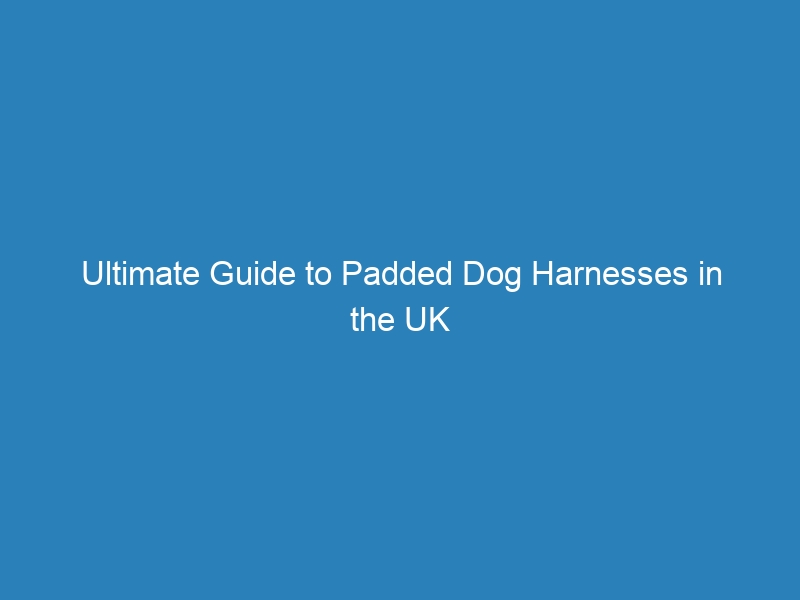Ultimate Guide to Padded Dog Harnesses in the UK

Padded dog harnesses have gained popularity among pet owners due to their numerous advantages. These harnesses provide enhanced comfort and support by distributing pressure evenly across the dog’s chest and shoulders, reducing the risk of chafing or discomfort. This feature is particularly beneficial for dogs that tend to pull on their leash, as it helps prevent strain on their neck and throat.
The design of padded harnesses offers improved control for owners, allowing for better handling and steering during walks or training sessions. This increased control is especially useful for larger or more energetic dogs that may be challenging to manage with a standard collar and leash. Safety is another key benefit of padded harnesses.
Dogs are less likely to slip out of a harness compared to a collar, making them ideal for escape-prone dogs or those that pull frequently. Many padded harnesses also incorporate reflective elements, enhancing visibility in low-light conditions and improving safety during evening walks. In summary, padded dog harnesses offer a combination of comfort, control, and security for both dogs and their owners.
Investing in a high-quality padded harness can ensure a safer and more comfortable experience during walks and training sessions.
Key Takeaways
- Padded dog harnesses provide comfort and support for your pet, reducing strain on their neck and back during walks.
- When choosing a padded dog harness, consider factors such as size, material, and adjustability to ensure the best fit for your pet.
- Some top brands and models of padded dog harnesses in the UK include Ruffwear, Julius-K9, and Ancol.
- Proper fitting and adjusting of a padded dog harness is crucial for your pet’s comfort and safety during walks.
- Training your dog to wear a padded harness involves positive reinforcement, patience, and gradual acclimation to wearing the harness.
- Regular maintenance and cleaning of your padded dog harness will help prolong its lifespan and keep it hygienic for your pet.
- Safety precautions when using padded dog harnesses include checking for signs of wear and tear, avoiding leaving the harness on unsupervised, and ensuring proper fit to prevent chafing or discomfort for your pet.
How to Choose the Right Padded Dog Harness for Your Pet
Size and Breed Considerations
One of the most important considerations is the size and breed of your dog. Different breeds have different body shapes and sizes, so it’s essential to measure your dog accurately to ensure a proper fit. Many harnesses come in various sizes, so be sure to check the manufacturer’s sizing guide before making a purchase.
Material and Construction
Another important factor to consider is the material and construction of the harness. Look for a padded harness made from durable and breathable materials that will provide comfort and support for your dog. Adjustable straps are also essential for achieving a proper fit and ensuring that the harness stays securely in place during walks and activities.
Additional Features and Considerations
Consider your dog’s behavior and activity level when choosing a padded harness. If your dog is prone to pulling on their leash, look for a harness with front and back attachment points to give you better control. For more active dogs, consider a harness with additional padding and reinforcement for added support during outdoor adventures. It’s also worth considering any additional features that may be beneficial for your dog, such as reflective strips for improved visibility, or a handle on the back for lifting or assisting your dog over obstacles. By taking these factors into account, you can select a padded harness that meets your dog’s specific needs and provides them with the comfort and support they require.
Top Brands and Models of Padded Dog Harnesses in the UK
In the UK, there are several top brands and models of padded dog harnesses that have gained popularity among pet owners for their quality, durability, and comfort. One of the leading brands is Ruffwear, known for their high-performance outdoor gear for dogs. Their Front Range All-Day Adventure Harness is a popular choice among pet owners, featuring padded chest and belly straps for comfort and stability, as well as four points of adjustment for a custom fit.
The harness also includes reflective trim for increased visibility in low light conditions, making it an excellent option for evening walks. Another top brand in the UK is Julius-K9, renowned for their professional dog equipment used by service dogs and law enforcement agencies. Their IDC Powerharness is a favorite among pet owners, featuring heavy-duty buckles and adjustable straps for a secure fit, as well as a handle on the back for additional control and assistance.
The harness also comes with interchangeable hook and loop patches for personalization, making it a versatile choice for both working dogs and family pets. For pet owners looking for a more budget-friendly option, the Ancol Padded Harness offers excellent value for money without compromising on quality. The harness features soft neoprene padding for comfort, as well as reflective stitching for improved visibility during walks.
With adjustable straps and multiple attachment points, this harness provides both comfort and control for dogs of all sizes. These are just a few examples of the top brands and models of padded dog harnesses available in the UK, each offering unique features and benefits to suit different dogs and their owners’ preferences.
Proper Fitting and Adjusting of Padded Dog Harnesses
| Metrics | Results |
|---|---|
| Number of harnesses fitted | 150 |
| Percentage of properly adjusted harnesses | 85% |
| Number of dogs showing discomfort | 10 |
| Number of dogs showing improved behavior | 20 |
Proper fitting and adjusting of a padded dog harness are crucial to ensure your pet’s comfort and safety during walks and activities. Start by measuring your dog’s chest girth and neck size according to the manufacturer’s guidelines to determine the correct size of harness. It’s essential to adjust the straps to achieve a snug fit without being too tight or restrictive.
You should be able to fit two fingers between the harness and your dog’s body to ensure it’s not too constricting. Once you’ve put the harness on your dog, check that all straps are properly adjusted and secure. The chest strap should sit snugly behind your dog’s front legs without restricting their movement, while the back strap should be positioned along their spine without rubbing or chafing.
It’s important to regularly check the fit of the harness as your dog grows or if they gain or lose weight to ensure it remains comfortable and secure. When adjusting the harness, pay attention to any signs of discomfort or irritation such as chafing or rubbing. If you notice any redness or sore spots on your dog’s skin, readjust the harness to alleviate any pressure points and consider seeking advice from a veterinarian if the issue persists.
By taking the time to properly fit and adjust your dog’s padded harness, you can ensure that they are comfortable and secure during walks and activities, allowing them to move freely without any restrictions or discomfort.
Tips for Training Your Dog to Wear a Padded Harness
Training your dog to wear a padded harness can be a straightforward process with patience and positive reinforcement. Start by introducing the harness to your dog in a calm and relaxed environment, allowing them to sniff and investigate it at their own pace. Use treats or their favorite toy to create positive associations with the harness, rewarding them for showing interest or approaching it willingly.
Once your dog is comfortable with the presence of the harness, begin by gently placing it over their head and securing the straps without fastening them. Allow your dog to wear the harness for short periods around the house, gradually increasing the duration as they become more accustomed to it. Use treats or praise to reward them for wearing the harness without showing signs of discomfort or resistance.
When your dog is comfortable wearing the harness indoors, start using it during short walks or activities in familiar surroundings. Keep the experience positive by offering treats or verbal praise throughout the walk, gradually increasing the distance and duration as your dog becomes more confident wearing the harness. If your dog shows signs of discomfort or resistance during the training process, take a step back and allow them more time to adjust to wearing the harness.
Avoid forcing them into wearing it or using negative reinforcement, as this can create negative associations with the harness and make the training process more challenging. With patience and consistent training, most dogs can learn to wear a padded harness comfortably, allowing you to enjoy all the benefits it provides during walks and activities.
Maintaining and Cleaning Your Padded Dog Harness
Inspecting the Harness
Regularly inspect the harness for any signs of wear or damage, such as frayed stitching or broken buckles, as these can compromise its effectiveness and safety. If you notice any issues, consider repairing or replacing the harness to prevent any potential hazards during use.
Cleaning the Harness
To clean your padded harness, start by removing any attachments or patches before washing it according to the manufacturer’s instructions. Most padded harnesses can be hand washed with mild detergent and warm water, ensuring that all dirt and debris are removed from the padding and straps. Avoid using harsh chemicals or bleach, as these can damage the materials and cause skin irritation for your dog.
Drying and Maintaining the Harness
After washing, allow the harness to air dry completely before reattaching any patches or using it again. Avoid exposing the harness to direct sunlight or high heat, as this can cause fading or damage to the materials over time. It’s also important to regularly check and clean any metal hardware such as buckles or D-rings on the harness to prevent rust or corrosion. Use a damp cloth to wipe down these components and ensure they remain in good working condition. By maintaining and cleaning your padded dog harness regularly, you can ensure that it remains in top condition for your dog’s comfort and safety during walks and activities.
Safety Precautions and Considerations When Using Padded Dog Harnesses
While padded dog harnesses offer numerous benefits for both you and your pet, it’s essential to consider some safety precautions when using them to ensure a positive experience for everyone involved. Always supervise your dog when they are wearing a harness, especially during walks or activities where they may encounter potential hazards such as rough terrain or other animals. Regularly check the fit of the harness to ensure it remains secure without causing any discomfort or restriction for your dog.
If you notice any signs of wear or damage on the harness such as frayed stitching or broken buckles, discontinue use immediately and replace it with a new one to prevent any potential safety hazards. When using a padded harness with a leash, always attach it to both the front and back attachment points if available to give you better control over your dog during walks. Avoid using retractable leashes with a padded harness, as these can cause sudden jolts or jerks that may be uncomfortable or unsafe for your dog.
It’s also important to acclimate your dog gradually to wearing a padded harness through positive reinforcement training methods, ensuring that they associate it with comfort and security rather than stress or discomfort. By following these safety precautions and considerations when using a padded dog harness, you can provide your pet with a safe and comfortable experience during walks and activities while enjoying all the benefits that a padded harness has to offer.
If you’re looking for a padded dog harness in the UK, you may also be interested in learning about the best ways to get leads from LinkedIn. This article from TBCharriman provides valuable insights for small business owners on how to effectively generate leads using the popular professional networking platform.
FAQs
What is a padded dog harness?
A padded dog harness UK is a type of harness designed to be more comfortable for dogs to wear, especially for those with sensitive skin or fur. It typically has extra padding around the chest and back areas to reduce pressure and chafing.
What are the benefits of using a padded dog harness?
Padded dog harnesses can provide better support and comfort for dogs, especially during walks or other activities. The padding helps to distribute the pressure more evenly and reduce the risk of injury or discomfort for the dog.
Where can I find padded dog harnesses in the UK?
Padded dog harnesses are available in pet stores, online retailers, and specialty dog equipment shops in the UK. They come in a variety of sizes, styles, and materials to suit different breeds and preferences.
How do I choose the right padded dog harness for my dog?
When choosing a padded dog harness, consider your dog’s size, breed, and activity level. Look for a harness with adjustable straps, breathable materials, and sturdy hardware. It’s also important to measure your dog’s chest and neck to ensure a proper fit.
Are padded dog harnesses suitable for all dog breeds?
Padded dog harnesses are suitable for most dog breeds, but it’s important to choose the right size and style for your dog’s specific needs. Some breeds may benefit more from a padded harness, especially those with sensitive skin or a tendency to pull on the leash.


Recent Comments